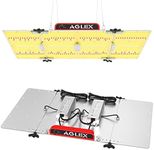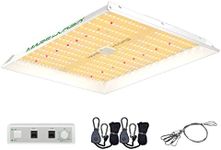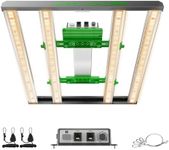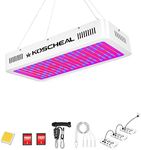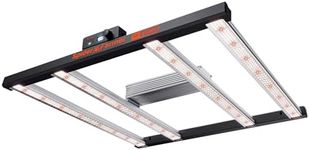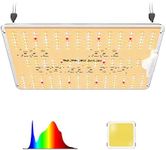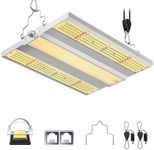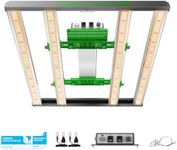Buying Guide for the Best Led Grow Lights
Choosing the right LED grow light is essential for healthy plant growth, whether you're growing herbs on your windowsill or managing a larger indoor garden. The right light can make a big difference in how well your plants grow, flower, and produce. To find the best fit, you need to understand the main features and how they relate to your specific growing needs, such as the type of plants, the size of your growing area, and your goals (like leafy greens versus fruiting plants).WattageWattage refers to the amount of power the LED grow light uses. It's important because it gives you a rough idea of how much light the fixture can produce, which affects how well your plants will grow. Lower wattage lights (under 100W) are suitable for small spaces or a few plants, while medium wattage (100-300W) works for medium-sized grow tents or shelves. High wattage lights (over 300W) are best for larger grow rooms or for growing plants that need a lot of light. To pick the right wattage, consider the size of your growing area and the light needs of your plants—leafy greens need less light than fruiting plants like tomatoes or peppers.
Light SpectrumThe light spectrum describes the range of colors (wavelengths) the LED emits. Plants use different parts of the spectrum for different growth stages: blue light helps with leafy growth, while red light encourages flowering and fruiting. Some lights offer a 'full spectrum,' which covers all the colors plants need from seedling to harvest. If you want a simple, all-purpose solution, full spectrum is a safe choice. If you want to fine-tune for specific stages, look for lights with adjustable spectrums or separate blue and red modes.
Coverage AreaCoverage area tells you how much space the light can effectively illuminate. This is important because if your light doesn't cover your whole growing area, some plants won't get enough light. Small lights might cover 1-2 square feet, while larger ones can cover 4 square feet or more. To choose the right coverage, measure your growing space and make sure the light you pick can cover it at the recommended hanging height.
PAR (Photosynthetically Active Radiation)PAR measures the amount of light in the spectrum that plants can actually use for photosynthesis. It's a more accurate way to judge how effective a grow light is than just looking at wattage. PAR values are usually given in micromoles per square meter per second (μmol/m²/s). Low PAR is fine for seedlings or shade-loving plants, medium PAR is good for leafy greens, and high PAR is needed for fruiting or flowering plants. Think about what you're growing and pick a light with a PAR output that matches those needs.
Heat OutputHeat output refers to how much warmth the light produces. While LEDs are cooler than other types of grow lights, they still generate some heat. Too much heat can stress plants or dry out soil quickly, while too little might not be enough for some tropical plants. If your growing area is small or enclosed, look for lights with good heat management (like built-in fans or heat sinks). If you need extra warmth, a slightly warmer light might help.
LifespanLifespan is how long the LED grow light is expected to last, usually measured in hours. Longer lifespan means less frequent replacements and lower maintenance. Most quality LED grow lights last between 30,000 and 50,000 hours. If you plan to grow year-round or for many years, a longer lifespan is a good investment.
Dimming and Control FeaturesSome LED grow lights come with dimming options or programmable timers. Dimming lets you adjust the light intensity for different plant stages, while timers can automate your light schedule. These features are helpful if you want more control or convenience, especially for sensitive plants or complex grow setups. If you prefer a 'set it and forget it' approach, look for lights with built-in timers or easy controls.
